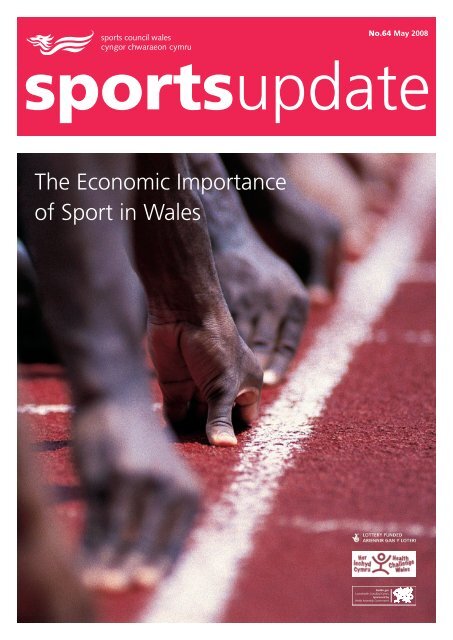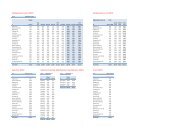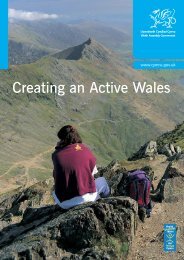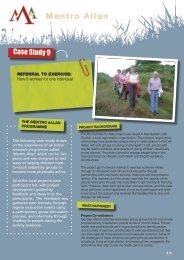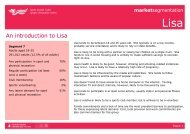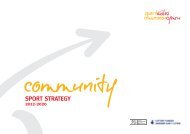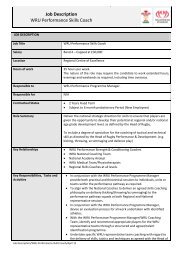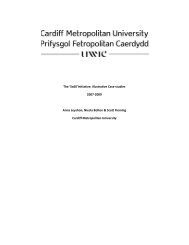The Economic Importance of Sport in Wales - Sport Wales
The Economic Importance of Sport in Wales - Sport Wales
The Economic Importance of Sport in Wales - Sport Wales
You also want an ePaper? Increase the reach of your titles
YUMPU automatically turns print PDFs into web optimized ePapers that Google loves.
Employment <strong>in</strong> <strong>Sport</strong>Table 4 shows sport-related employment for the years1998 and 2004. Employment statistics <strong>in</strong> the report arecalculated by us<strong>in</strong>g sport related wages and averagesalaries for each sector <strong>of</strong> the sport economy. It shouldbe noted that, s<strong>in</strong>ce the last report, the employmentfigures for 1998 have been revised downwards because<strong>of</strong> the availability <strong>of</strong> new <strong>in</strong>formation about thegambl<strong>in</strong>g sector which has cast doubt on assumptionsmade about the 1998 employment statistics.<strong>Sport</strong> employment <strong>in</strong>creased from 19,400 <strong>in</strong> 1998 to23,200 <strong>in</strong> 2004 represent<strong>in</strong>g a 20 per cent rise. <strong>The</strong>biggest improvements are <strong>in</strong> education, sports facilitiesand the commercial non sport sector with growth ratesrang<strong>in</strong>g between 45 per cent and 25 per cent over theexam<strong>in</strong>ed period.Table 4: <strong>Sport</strong>s-related Employment (thousands)1998 2004Commercial non sport sector 8.9 11.1Voluntary sport 2.0 2.0<strong>Sport</strong> retail<strong>in</strong>g 3.0 3.4Spectator clubs 1.2 1.2<strong>Sport</strong>s facilities 1.8 2.4Education 1.1 1.6Other 1.4 1.5Total 19.4 23.2Comparison with 1998Table 5 provides a comparison <strong>of</strong> the three ma<strong>in</strong><strong>in</strong>dicators <strong>of</strong> the sports economy (Consumerexpenditure, Value added, and Employment) for theyears 1998 and 2004. On the basis <strong>of</strong> sportsparticipation, sports gambl<strong>in</strong>g and TV markets growth,the share <strong>of</strong> sports related consumer expenditure hasreached the 2.3% level. This is below the UK average <strong>of</strong>2.6%. However <strong>Wales</strong> outperforms the UK average <strong>in</strong>terms <strong>of</strong> the share <strong>of</strong> sport related value added (1.8%)and employment (1.8%) <strong>in</strong> the economy.Table 5: Ma<strong>in</strong> Indicators (£million)1998 2004Consumer expenditure 539 707Percentage <strong>of</strong> <strong>Wales</strong> total 2.2% 2.3%Equivalent UK statistic 2.3% 2.6%Value added 531 704Percentage <strong>of</strong> <strong>Wales</strong> total 1.7% 1.8%Equivalent UK statistic 1.5% 1.6%Employment (thousands) 19.4 23.2Percentage <strong>of</strong> <strong>Wales</strong> total 1.6% 1.8%Equivalent UK statistic 1.4% 1.6%Conclusions<strong>The</strong> results <strong>of</strong> this survey emphasise the importance <strong>of</strong>sport to the Welsh economy. Not only does sportgenerate a significant amount <strong>of</strong> consumer expenditure,value added and employment, the relative importance<strong>of</strong> these factors <strong>in</strong> the Welsh economy is <strong>in</strong>creas<strong>in</strong>g. Itwill be <strong>in</strong>terest<strong>in</strong>g to track comparative statistics overthe next five years at a time when the pr<strong>of</strong>ile <strong>of</strong> sport <strong>in</strong><strong>Wales</strong> will be <strong>in</strong>creased by major events such as theRyder Cup <strong>in</strong> Newport, the England v Australia testmatch <strong>in</strong> Cardiff and the London Olympics.6 sportsupdate No.64 May 2008
<strong>The</strong> <strong>Economic</strong> <strong>Importance</strong> Of <strong>Sport</strong> In <strong>Wales</strong>Further Read<strong>in</strong>g<strong>The</strong> follow<strong>in</strong>g references should be <strong>of</strong> <strong>in</strong>terest to thosewho wish to explore this area further. <strong>The</strong>y are arranged<strong>in</strong> two sequences: those specifically relat<strong>in</strong>g to <strong>Wales</strong>,and those with a broader remit. Copies are available torefer to <strong>in</strong> the <strong>Sport</strong>s Council for <strong>Wales</strong> InformationCentre.<strong>Wales</strong> References(2002) Rais<strong>in</strong>g the pr<strong>of</strong>ile: major sport<strong>in</strong>g events andWelsh regional development, Welsh <strong>Economic</strong>Review, Spr<strong>in</strong>g 2002, 10-11Despite its <strong>in</strong>ability to close the GDP gap to the rest <strong>of</strong>the UK, or to produce enough entrepreneurs or smallbus<strong>in</strong>esses, <strong>Wales</strong> does lead the UK <strong>in</strong> its ability toattract globally significant sport<strong>in</strong>g events. <strong>The</strong> shortand long term economic impacts <strong>of</strong> such events aretherefore subjects <strong>of</strong> some importance.(2002) Welsh <strong>Economic</strong> Research Unit Conference,Welsh <strong>Economic</strong> Review, Autumn 2002, 5-14.In May 2002, the WERU held its 10th annual conferenceand the theme was 'Flex<strong>in</strong>g Welsh Muscle: <strong>Sport</strong> and<strong>Economic</strong> Development'. Follow<strong>in</strong>g the conference,speakers were <strong>in</strong>vited to provide a summary <strong>of</strong> theirpresentations which are published <strong>in</strong> this article. Includespapers on sport and economic regeneration, the UKmotor sport <strong>in</strong>dustry, the economic value to <strong>Wales</strong> <strong>of</strong>host<strong>in</strong>g the Ryder Cup, and rugby <strong>in</strong> the community.Henley Centre for Forecast<strong>in</strong>g and <strong>Sport</strong>s Council for<strong>Wales</strong> (1990) <strong>Sport</strong> and the Welsh economy: a studyby the Henley Centre, Cardiff: <strong>Sport</strong>s Council for <strong>Wales</strong>.This study is the first attempt to quantify the economic<strong>in</strong>puts, outputs and flows result<strong>in</strong>g from the existence<strong>of</strong> sport <strong>in</strong> the economy <strong>of</strong> <strong>Wales</strong>. <strong>The</strong> pr<strong>in</strong>cipal aimhas been to provide a snapshot <strong>of</strong> the role <strong>of</strong> sport <strong>in</strong>the economy and thereby to raise general awareness <strong>of</strong>that role.Institute <strong>of</strong> Welsh Affairs and David, R (ed) (2007) <strong>Sport</strong>and economic regeneration: measur<strong>in</strong>g andmaximis<strong>in</strong>g the benefits for <strong>Wales</strong>, Cardiff: Institute<strong>of</strong> Welsh AffairsConta<strong>in</strong>s presentations from a Conference on <strong>Sport</strong> and<strong>Economic</strong> Regeneration held by the Institute <strong>of</strong> WelshAffairs <strong>in</strong> late 2006. Includes papers on: the economicreturn to regions <strong>of</strong> new stadia and big events; achiev<strong>in</strong>gimpact through sport; gett<strong>in</strong>g benefits from theOlympics; the Ryder Cup and its importance to <strong>Wales</strong>.Segal Qu<strong>in</strong>ce Wicksteed Limited, <strong>Wales</strong> Tourist Boardand System Three (2000) Rugby World Cup 1999:economic impact evaluation, summary reportProvides a summary <strong>of</strong> an evaluation <strong>of</strong> the tournamentcommissioned by the <strong>Wales</strong> Tourist Board. <strong>The</strong>evaluation centred around a programme <strong>of</strong> researchwhich was undertaken before the event to establish abasel<strong>in</strong>e and <strong>in</strong> October/November 1999 to gatherevent-related <strong>in</strong>formation.Snowdonia-Active (2004) <strong>The</strong> active economy: thevalue <strong>of</strong> adventurous outdoor activities to NorthWest <strong>Wales</strong>Aims to establish the contribution <strong>of</strong> the adventuretourism <strong>in</strong>dustry to the local economy <strong>of</strong> the area with<strong>in</strong>the Snowdonia National Park as well as the widereconomy <strong>of</strong> North West <strong>Wales</strong>.<strong>Sport</strong>s Council for <strong>Wales</strong> (2000) <strong>The</strong> economic impact<strong>of</strong> sport <strong>in</strong> <strong>Wales</strong>: 1998, Cardiff: <strong>Sport</strong>s Council for<strong>Wales</strong>This is the fourth study to be undertaken look<strong>in</strong>g at theeconomic impact <strong>of</strong> sport <strong>in</strong> <strong>Wales</strong>. It aims to provide asnapshot <strong>of</strong> the role and significance <strong>of</strong> sport <strong>in</strong> <strong>Wales</strong>.<strong>Sport</strong>s Council for <strong>Wales</strong> (1995) <strong>The</strong> economic impact<strong>of</strong> sport <strong>in</strong> <strong>Wales</strong>, Cardiff: <strong>Sport</strong>s Council for <strong>Wales</strong>This is the second study to be undertaken look<strong>in</strong>g at theeconomic impact <strong>of</strong> sport <strong>in</strong> <strong>Wales</strong>. It aims to provide asportsupdate No.64 May 2008 7
<strong>The</strong> <strong>Economic</strong> <strong>Importance</strong> Of <strong>Sport</strong> In <strong>Wales</strong>"snapshot" <strong>of</strong> the role and significance <strong>of</strong> sport <strong>in</strong> theWelsh economy, highlight<strong>in</strong>g changes that have occurredbetween 1988 and 1994 and assess<strong>in</strong>g the implicationsfor the future <strong>of</strong> the sport<strong>in</strong>g <strong>in</strong>dustry <strong>in</strong> <strong>Wales</strong>.<strong>Sport</strong>s Council for <strong>Wales</strong> (1990) <strong>Sport</strong> and the Welsheconomy, Cardiff: <strong>Sport</strong>s Council for <strong>Wales</strong>Summarises the results <strong>of</strong> a study <strong>of</strong> sport and theWelsh economy which was the first attempt to quantifythe economy <strong>in</strong>puts, outputs and flows result<strong>in</strong>g fromthe existence <strong>of</strong> sport <strong>in</strong> <strong>Wales</strong>.Welsh Institute <strong>of</strong> Rural Studies and Midmore, Peter(2000) <strong>The</strong> economic value <strong>of</strong> walk<strong>in</strong>g <strong>in</strong> rural<strong>Wales</strong>, Aberystwyth: Welsh Institute <strong>of</strong> Rural AffairsThis study, which draws on research work <strong>in</strong> <strong>Wales</strong> andScotland, shows that 4,800 jobs and £132 million <strong>of</strong><strong>in</strong>come are generated by walk<strong>in</strong>g <strong>in</strong> <strong>Wales</strong>.General ReferencesCouncil <strong>of</strong> Europe and Jones, Huw (1989)<strong>The</strong> economic impact and importance <strong>of</strong> sport:a European study, Strasbourg: Council <strong>of</strong> EuropeLooks at the impact <strong>of</strong> economics on sport <strong>in</strong> Europe,sports contribution to national economies, and some <strong>of</strong>the implications for policy makers.Crompton, John L (1995) <strong>Economic</strong> impact analysis <strong>of</strong>sports facilities and events: eleven sources <strong>of</strong>misapplication. Journal <strong>of</strong> <strong>Sport</strong> Management,January 1995, 14-35Many sports events and facilities are subsidised eitherdirectly or <strong>in</strong>directly by <strong>in</strong>vestments from public sectorfunds and there has been an <strong>in</strong>creased use <strong>of</strong> economicimpact analysis to support public subsidy. Many <strong>of</strong> theseanalyses report <strong>in</strong>accurate results and this paper presentsand discusses 11 major contributors to the <strong>in</strong>accuracy.Gratton, Chris, Dobson, Nigel and Shibli, Simon (2000)<strong>The</strong> economic importance <strong>of</strong> major sports events: acase-study <strong>of</strong> six events. Manag<strong>in</strong>g Leisure,January 2000, 17-28This paper reports the results <strong>of</strong> an economic impactassessment <strong>of</strong> six major sports events held <strong>in</strong> the UK <strong>in</strong>1997. <strong>The</strong> results <strong>in</strong>dicate the wide variability <strong>in</strong>economic benefits as well as the difficulty sometimesencountered <strong>in</strong> predict<strong>in</strong>g what these benefits will beprior to the stag<strong>in</strong>g <strong>of</strong> an event. An attempt is made todevelop a typology <strong>of</strong> major sports events <strong>in</strong> terms <strong>of</strong>their potential to generate significant economic impact.Gratton, Chris and Taylor, Peter (2000) <strong>Economic</strong>s <strong>of</strong>sport and recreation, London: E.& F.N. SponCovers a key part <strong>of</strong> sports management and sportsstudies courses, and gives particular emphasis to therole and importance <strong>of</strong> the commercial sector <strong>in</strong> sport<strong>in</strong>clud<strong>in</strong>g the economics <strong>of</strong>: the sports goods <strong>in</strong>dustry;sports sponsorship, major sports events, pr<strong>of</strong>essionalteam sports; and the relationship between sport andbroadcast<strong>in</strong>g.Gratton, Chris (ed) and Henry, Ian P (ed) (2001) <strong>Sport</strong><strong>in</strong> the city: the role <strong>of</strong> sport <strong>in</strong> economic and socialregeneration, London: RoutledgeCities are <strong>in</strong>creas<strong>in</strong>gly us<strong>in</strong>g major sport<strong>in</strong>g events andactivities to re-image themselves, promote urbandevelopment and fund economic growth andregeneration. This book looks at how sport has beenused <strong>in</strong> contemporary cities across the world, andevaluates policies, strategies and management. Key areasexam<strong>in</strong>ed are: sport and urban economic regeneration;sports events bidd<strong>in</strong>g; plann<strong>in</strong>g and organisation; urbansports tourism; sport and urban communitydevelopment; urban politics and sports policy.Henley Centre and <strong>Sport</strong>s Council (1990)<strong>The</strong> economic impact <strong>of</strong> sport <strong>in</strong> the UnitedK<strong>in</strong>gdom <strong>in</strong> 1990, London: <strong>Sport</strong>s Council<strong>The</strong> ma<strong>in</strong> aim <strong>of</strong> this study is to provide a "snapshot" <strong>of</strong>the role <strong>of</strong> sport <strong>in</strong> the economy and thereby to raisegreater awareness <strong>of</strong> that role. <strong>The</strong> overall structure <strong>of</strong>the study is provided by the system <strong>of</strong> national accounts.Henley Centre for Forecast<strong>in</strong>g and <strong>Sport</strong>s Council (1991)Consumer spend<strong>in</strong>g on sport-related goods andservices <strong>in</strong> the United K<strong>in</strong>gdom, London: <strong>Sport</strong>sCouncilExam<strong>in</strong>es consumer expenditure on sport-related goodsand services as a relatively self-conta<strong>in</strong>ed segment <strong>of</strong>the sports <strong>in</strong>dustry <strong>in</strong> order to ga<strong>in</strong> some sense <strong>of</strong> thegrowth <strong>of</strong> the <strong>in</strong>dustry.Henley Centre for Forecast<strong>in</strong>g and <strong>Sport</strong>s Council (1989)<strong>The</strong> economic impact and importance <strong>of</strong> sport <strong>in</strong>two local areas: Bracknell and the Wirral, London:<strong>Sport</strong>s CouncilThis study focused on the local economic impact <strong>of</strong>sport, look<strong>in</strong>g at the economic contribution <strong>of</strong> thesports sector to the local economy, particularly thecontribution to the local employment base.Kesenne, Stefan (1998) Cost benefit-analysis <strong>of</strong> sportevent, European Journal for <strong>Sport</strong> Management,Vol 5, No 2, 44-49<strong>The</strong> author discusses the most important conceptualerrors <strong>in</strong> cost-benefit analysis <strong>of</strong> sports events andpublic <strong>in</strong>vestments <strong>in</strong> sport. Overestimation <strong>of</strong> the netbenefit turns out to be the major problem.8 sportsupdate No.64 May 2008
<strong>The</strong> <strong>Economic</strong> <strong>Importance</strong> Of <strong>Sport</strong> In <strong>Wales</strong>Solberg, Harry Arne (2003) Major sport<strong>in</strong>g events:assess<strong>in</strong>g the value <strong>of</strong> volunteers' work, Manag<strong>in</strong>gLeisure, Vol 8, No 1, January 2003, 17-27This article assesses the value <strong>of</strong> volunteers' work atsport<strong>in</strong>g events, based on two different theoreticalapproaches; the Opportunity Cost Approach (OCA) andthe Market Price <strong>of</strong> Equivalency model (MPE). <strong>The</strong> OCAmethod assesses the value <strong>of</strong> the displacement <strong>of</strong> othergoods and services elsewhere <strong>in</strong> society. In addition, italso takes <strong>in</strong>to account that people enjoy volunteer<strong>in</strong>g.<strong>The</strong> MPE model evaluates what it will cost to purchasethe equivalent services that volunteers provide atmarket prices. This article also presents an empiricalstudy from a major sport<strong>in</strong>g event: the 1999 World IceHockey Championship.Stabler, Mike and Ravenscr<strong>of</strong>t, Neil (1993) <strong>The</strong> economicevaluation <strong>of</strong> output <strong>in</strong> leisure services, Read<strong>in</strong>g:Department <strong>of</strong> <strong>Economic</strong>s, University <strong>of</strong> Read<strong>in</strong>g<strong>The</strong> <strong>in</strong>tention <strong>of</strong> this paper was to <strong>in</strong>vestigate an aspect<strong>of</strong> the economics <strong>of</strong> public leisure provision, namely theevaluation <strong>of</strong> non-f<strong>in</strong>ancial service output. <strong>The</strong> authorsuse a case study to demonstrate to what extent thelocal authority attempts to measure output, and <strong>in</strong> whatform, as an <strong>in</strong>dication <strong>of</strong> its effectiveness <strong>in</strong> achiev<strong>in</strong>g itsdesignated goals.UK <strong>Sport</strong> (1999) Major events: the economics,London: UK <strong>Sport</strong>Provides an overview <strong>of</strong> the economic impact associatedwith the stag<strong>in</strong>g <strong>of</strong> major sport<strong>in</strong>g events.UK <strong>Sport</strong> (2004) Measur<strong>in</strong>g success 2: the economicimpact <strong>of</strong> major sports events, London: UK <strong>Sport</strong>Presents an overview <strong>of</strong> the f<strong>in</strong>d<strong>in</strong>gs from 16 economicimpact studies <strong>of</strong> major sports events staged <strong>in</strong> the UKs<strong>in</strong>ce 1997.Wilson, Robert (2006) <strong>The</strong> economic impact <strong>of</strong> localsport events: significant, limited or otherwise? A casestudy <strong>of</strong> four swimm<strong>in</strong>g events, Manag<strong>in</strong>g Leisure,Vol 11, No 1, January 2006, 57-70;It is widely recognised that sports events can act as acatalyst for economic development and urbanregeneration. Much has been made <strong>of</strong> the potentialeconomic benefits <strong>of</strong> host<strong>in</strong>g major sports events, andresearch <strong>in</strong> the UK has <strong>in</strong> general focused on theeconomic impacts <strong>of</strong> sport events such as the 2000 FloraLondon Marathon, 2001 World Snooker Championshipsand the 2001 World Half Marathon. However, while all<strong>of</strong> these studies have focused on so called 'major' eventsthis study exam<strong>in</strong>es much smaller ones.sportsupdate No.64 May 2008 9
<strong>The</strong> <strong>Economic</strong> <strong>Importance</strong> Of <strong>Sport</strong> In <strong>Wales</strong>10 sportsupdate No.64 May 2008
<strong>The</strong> <strong>Economic</strong> <strong>Importance</strong> Of <strong>Sport</strong> In <strong>Wales</strong>AppendixAppendix 1 – Statistical SourcesSources <strong>of</strong> data <strong>in</strong>cluded <strong>in</strong> the Model <strong>in</strong>cluded:• Consumer Trends• Travel Trends• Family Spend<strong>in</strong>g• Regional Trends• Annual Bus<strong>in</strong>ess Inquiry• New Earn<strong>in</strong>gs Survey• <strong>Sport</strong> Council for <strong>Wales</strong> Annual Report• Regional Accounts• Leisure and Recreation Statistics• General Household Survey• National Travel Survey• Hous<strong>in</strong>g & Construction Statistics• National Accounts• BBC Annual Report and Accounts• UK Markets• HM Customs and Excise Report• Monthly Digest <strong>of</strong> Statistics• F<strong>in</strong>ancial Statement and Budget Report• Horserace and Bett<strong>in</strong>g Levy Board Report• Government’s Expenditure Plans• Survey <strong>of</strong> Football Clubs Accounts – Touche Ross• BSkyB Annual Report• Labour Trendssportsupdate No.64 May 2008 11


